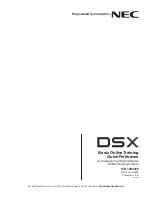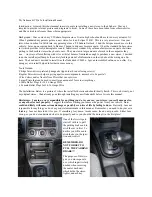
R2 May. 2002
10
PMA7000MS-Option CD Pilot Guide
The lower button (play/pause/advance) is used to play the disc from stop,
pause play, and advance the track. When the disc is stopped, pushing the
button starts play. A short push will pause play. A longer press advances the
track. Holding the button acts as a intro/scan, playing the
first two seconds of each track until released.
The top button is used to stop and eject the disc. Press mo-
mentarily to stop, press and hold to eject. Pushing BOTH
buttons momentarily will cause the CD to “back up.” If
pushed in mid song, it will back up to the beginning of the
track. At the beginning of a song, it will go back to the pre-
vious track.
This “back-up” feature implemented with Software Release
BBBB
for units without IRS and
FBBBB
for units with IRS and later. The
software version is found on the side of unit by serial label.
Holding BOTH buttons in for more than two seconds will cause the CD
player to power down.
NOTE: In order to restore CD operation you must cycle power on the
PMA7000MS-CD.
1.9
Marker Beacon (PMA7000MS-CD)
The optional Marker Beacon Receiver uses visual and audio indicators to
alert you when the aircraft passes over a 75 MHz transmitter.
The Blue lamp, labeled "O," is the Outer Marker lamp and has an associ-
ated 400 Hertz 'dash' tone. The lamp and tone will be keyed at a rate of two
tones/flashes per second when the aircraft is in
the range of the Outer Marker Beacon.
The Amber lamp, labeled "M," is the Middle
Marker lamp and is coupled with a 1300 Hertz
tone. It is keyed alternately with short 'dot' and
long 'dash' bursts at 95 combinations per min-
ute.
The White lamp, labeled "I," is the Inner marker and has a 3000 Hertz 'dot'
tone. The lamp and tone will be keyed at a rate of six times per second.
The audio from the Marker Beacon Receiver can be heard by selecting the
"MKR" push-button switch. To adjust the volume level, there is a service
adjustment located on the top of the unit.
A three-position switch is used to set the receiver sensitivity and to test the
indicator lamps. Use "
HI
" sensitivity initially. This allows you to hear the
outer marker beacon about a mile out. Then select the “
LO
” sensitivity to
give you a more accurate location of the Outer Marker. The momentary
down switch position is marker test, labeled "T/M" and illuminates all three
R2 May. 2002
3
PMA7000MS Option CD Pilot Guide
cuits. To re-enable the PCD7100-R, cycle power on the PMA7000MS-CD .
The power switch also controls the audio selector panel functions, intercom,
CD player and marker beacon receiver, (PMA7000MS-CD only).
1.3
Microphone (XMT) Selection (All models)
There are six push-buttons associated with the communications transceiv-
ers. The lower buttons control which transceiver is selected for transmit.
The PMA7000MS-CD gives priority to the pilot’s PTT. If the copilot it
transmitting, and the pilot presses his PTT, the pilot’s microphone will be
heard over the selected
com transmitter.
The PMA7000MS-CD-
Series has an automatic
selector mode. Audio
from the selected trans-
ceiver is automatically
heard in the headsets and
speaker (if selected). You can check this function by switching from C
OM
1
to C
OM
2 and watch the selected audio light on the selector change from
COM 1 to COM 2. This ensures the pilot will
always
hear the audio from
the transceiver he is transmitting on.
When switching from C
OM
1 to C
OM
2, while C
OM
2 audio had been se-
lected, Com 1 audio will continue to be heard. This eliminates the pilot hav-
ing to switch Com 1 audio back on, if desired.
When switching from C
OM
1 to C
OM
2 while Com 2 has NOT been se-
lected, Com 1 audio will be switched off. In essence, switching the mic se-
lector will not effect the selection of Com receiver audio.
When the duplex, or TELEPHONE mode is implemented, Com 3 becomes
the “TEL” position . This is the pilot’s “off-hook” switch, when the system
is interfaced to an appropriate approved wireless telecommunication sys-
tem, such as the AirCell system. Selecting Com 3 places the pilot micro-
phone and headphones on the telephone. The pilot PTT will switch the pilot
mic to the other selected com transceiver, and allow continued aircraft com-
munications as well.
The copilot will also be able to transmit on the selected com PTT as well.
NOTE: Selecting the COM 3 –TEL– mode will disable pilot and copilot
intercom, as the intercom circuit is transferred to the telephone use. In crew
or ISO mode, placing the switch in TEL mode removes the passengers ac-
cess to the telephone.
RCV
XMT
























